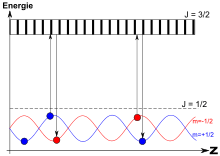Sisyphus cooling

Sisyphus cooling (sometimes called polarization gradient cooling) is a type of laser cooling of atoms used to reach temperatures below the Doppler cooling limit. This cooling method was first proposed by Claude Cohen-Tannoudji in 1989, for which he received part of the Nobel Prize in Physics in 1997.
Sisyphus cooling can be achieved by shining two counter-propagating laser beams with orthogonal polarization onto an atom sample. The two interfering beams create a standing wave with a polarization gradient that alternates between σ+, π and σ− polarisation. Atoms moving through the potential landscape along the direction of the standing wave lose kinetic energy as they move to a potential maximum, at which point optical pumping moves them to a lower-energy state, thus ridding them of the potential energy they carried.
Repeated cycles of converting kinetic energy to potential energy, and subsequent loss of this potential energy via optical pumping, allow the atoms to reach temperatures orders of magnitude below those available through simple Doppler cooling.
The technique is named after Sisyphus, a figure in the Greek mythology, who was doomed, for all eternity, to roll a stone up a mountain only to have it roll down again whenever he got near the summit.
References
- Metcalf, Harold J.; van der Straten, Peter (1999). Laser Cooling and Trapping. Springer. Section 8.8. ISBN 9780387987286.